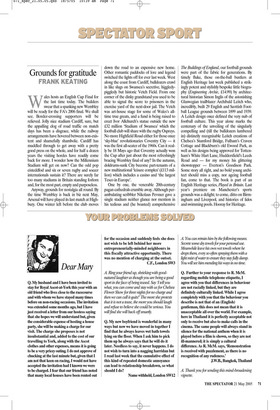Grounds for gratitude
FRANK KEATING
Wales hosts an English Cup Final for the last time today. The builders swear that a spanking new Wembley will be ready for the FA’s 2006 final. We shall see. Border-crossing supporters will be relieved. Jolly nice stadium Cardiff, sure, but the appalling clog of road traffic on match days has been a disgrace, while the railway arrangements have hovered between non-existent and shamefully shambolic. Cardiff has muddled through to get away with a pretty good press on the whole, and for half a dozen years the visiting hordes have readily come back for more. I wonder how the Millennium Stadium will get on now? Can the odd pop eisteddfod and six or seven rugby and soccer internationals sustain it? There are surely far too many stadiums in Britain standing forlorn and, for the most part, empty and purposeless.
Anyway, grounds for nostalgia all round. By the time Wembley is back in biz next May, Arsenal will have played its last match at Highbury. One winter left before the club moves down the road to an expensive new home. Other romantic paddocks of lore and legend switched the lights off for ever last week. West along the coast from Cardiff, bulldozers crawl in like slugs on Swansea’s secretive, higgledypiggledy but historic Vetch Field. From one corner of the dinky grandstand you used to be able to signal the score to prisoners in the exercise yard of the next-door jail. The Vetch was art-house stage for some of Wales’s alltime true greats, and a fund is being raised to erect Ivor Allchurch’s statue outside the new £32 million ‘Stadium of Swansea’ which the football club will share with the rugby Ospreys. No more Highfield Road either for those once ‘sky-blue’ revolutionaries Coventry City — it was the first all-seater of the 1960s. Can it really be 18 Mays ago that Coventry actually won the Cup after just about the most refreshingly bracing Wembley final of any? In the autumn, doldrums-sunk City become part-tenants of a new multinational ‘leisure complex’ (£113 million) which includes a casino and ‘the largest Tesco in Europe’.
One by one, the venerable 20th-century pagan cathedrals crumble away. Although perambulating scribbler Nikolaus Pevsner gave a single stadium neither glance nor mention in his tedious and (he boasted) comprehensive The Buildings of England, our football grounds were part of the fabric for generations. By timely fluke, those on-the-ball bustlers at English Heritage last week published a strikingly potent and stylishly bespoke little biography (Engineering Archie, £14.99) by architectural historian Simon Inglis of the astonishing Glaswegian trailblazer Archibald Leitch who, incredibly, built 29 English and Scottish Football League grounds between 1899 and 1939. A Leitch design once defined the very nub of football culture. This year alone marks the centenary of the unveiling of the singularly compelling and (till the bulldozers lumbered in) distinctly recognisable Leitch creations of Chelsea’s Stamford Bridge, Fulham’s Craven Cottage and Blackburn’s old Ewood Park, as well as his designs being approved for Tottenham’s White Hart Lane, Huddersfield’s Leeds Road and — for my money his glittering showstopper — Everton’s Goodison Park. Some story all right, and no bold young architect should miss a copy, nor ageing football fan, come to that. The book is part of an English Heritage series, Played in Britain. Last year’s premiere on Manchester’s sports grounds was a delight; to come, ditto on Birmingham and Liverpool, and histories of lidos and swimming pools. Hooray for Heritage.

























































 Previous page
Previous page